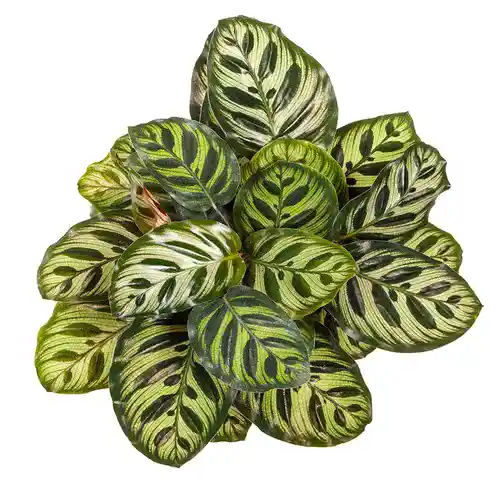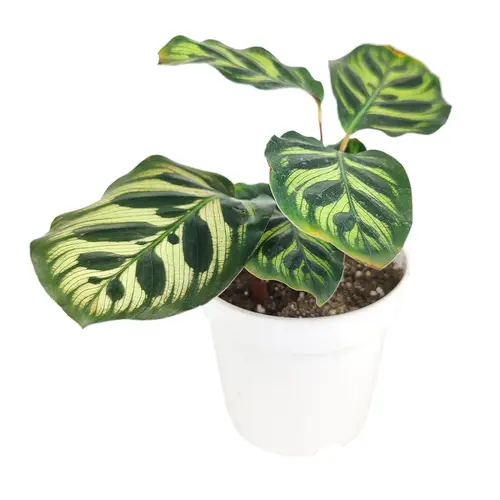Calathea Makoyana, also known as the Peacock Plant, is a beautiful houseplant that requires specific care to thrive.
Calathea Makoyana Plant Care:

1. Light:
- Bright, Indirect Light: This is crucial. Calathea Makoyana prefers medium to bright indirect light, mimicking its natural habitat on the rainforest floor where sunlight is filtered through a dense canopy.
- Avoid Direct Sun: Direct sunlight will cause the vibrant patterns on its leaves to fade and can even lead to scorched patches.
- Placement: An ideal spot is near a north or east-facing window. If placed in a very bright room, consider using sheer curtains to diffuse the light.
2. Watering:
- Consistently Moist Soil: Calathea Makoyana prefers semi-moist soil. Water when the top 1-2 inches of soil feel dry to the touch.
- Avoid Soggy Soil: Never let the soil become waterlogged, as this can lead to root rot.
- Water Type: These plants are sensitive to chemicals like fluoride found in tap water, which can cause brown leaf tips. Use distilled water, rainwater, or filtered water. If using tap water, let it sit out overnight to allow chlorine to evaporate.
- Temperature: Use room temperature water; cold water can shock the plant’s roots.
- Seasonality: Water more frequently during the growing season (spring and summer) and reduce frequency in winter when growth slows, but don’t let the soil dry out completely.
3. Humidity:
- High Humidity is Key: Calathea Makoyana thrives in high humidity (ideally 60% or higher) as it’s native to tropical rainforests. Low humidity is a common cause of browning or curling leaves.
- How to Increase Humidity:
- Humidifier: Place the plant near a humidifier.
- Pebble Tray: Place the pot on a tray filled with pebbles and water (make sure the pot isn’t sitting in the water).
- Misting: Mist the leaves regularly, especially in the mornings.
- Grouping Plants: Group your Calathea with other plants that release humidity to create a microclimate.
- Bathroom/Terrarium: A well-lit bathroom or terrarium can provide naturally higher humidity.
4. Temperature:
- Consistent Warmth: Maintain indoor temperatures between 18°C-24°C (65°F-75°F).
- Avoid Extremes: Keep your Calathea away from cold drafts (open windows, frequently used doors) and sources of heat (radiators, air vents) as sudden temperature changes can cause stress and damage.

5. Soil:
- Well-Draining and Moisture-Retentive: Use a potting mix that retains moisture but drains well to prevent root rot.
- Recommended Mix: A good mix can include a blend of peat-free soil, perlite, and orchid bark. A 2:1 ratio of peat moss to perlite or sand is often recommended. Adding organic matter like compost can also be beneficial.
- Drainage Holes: Always use a pot with drainage holes.
6. Fertilization:
- During Growing Season: Feed with a diluted, balanced liquid houseplant fertilizer every 4-6 weeks during the spring and summer (growing season).
- Avoid Winter Fertilization: Do not fertilize in winter when the plant is dormant.
7. Repotting:
- When to Repot: Calathea Makoyana can stay in its original pot for 1-2 years. Repot when you see roots growing out of the bottom of the pot, indicating it’s root-bound.
- Timing: Repotting is best done in spring or early summer during its active growth phase.
- Process: Water the plant thoroughly the day before. Gently remove from the pot, tease apart roots if needed, and repot into a container 1-2 inches larger with fresh potting mix.
8. Troubleshooting Common Issues:
- Drooping Leaves: Often a sign of thirst. Check the soil and water if dry. Leaves can also naturally droop during the day and move upwards at night.
- Curling Leaves: Can indicate cold stress (keep away from drafts) or a need for water. Also, low humidity is a common cause.
- Brown Leaf Tips/Edges: Most commonly caused by low humidity, sensitive reaction to chemicals in tap water (fluoride), or sometimes too much direct sun or drafts.
- Yellowing Leaves/Mushy Stems: Symptoms of overwatering and potential root rot.
- Fading Variegation: Too much direct sunlight.
- Pests: Calatheas can be susceptible to spider mites, mealybugs, and fungus gnats. Regularly wipe down leaves and treat with insecticidal soap or neem oil if pests are present.

Additional Tips:
- Leaf Cleaning: Wipe leaves with a damp cloth every 2-3 weeks to remove dust and help the plant breathe.
- Pet Friendly: Calathea Makoyana is considered non-toxic to cats and dogs.
Only logged in customers who have purchased this product may leave a review.












 If you need any assistance, I'm always here. Have you found what you were looking for?
If you need any assistance, I'm always here. Have you found what you were looking for?
Reviews
There are no reviews yet.